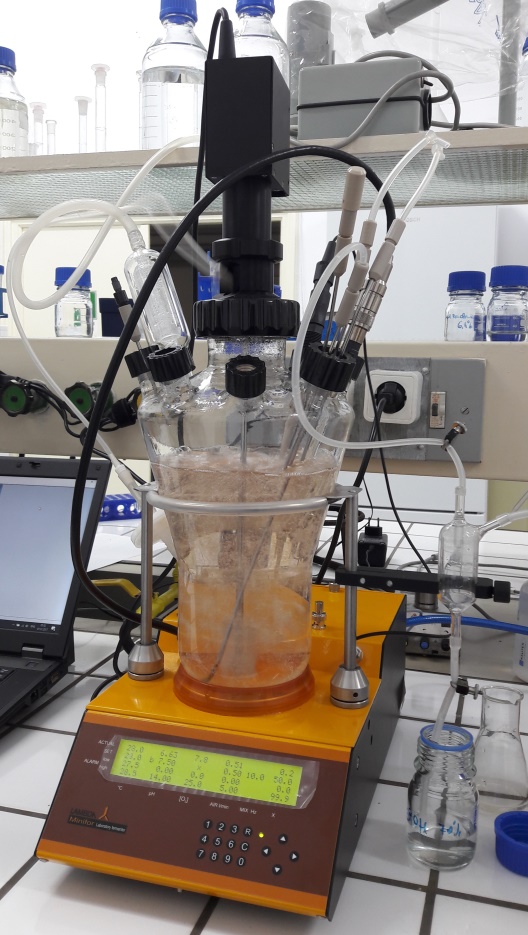ArthroBiotech
Developing an Arthrobacter nicotinovorans
biotechnology for neuro-pharmaceuticals production
PN-III-P1-1.1-TE-2016-0367
- Research project financed by the Ministry of Education and Scientific Research - Executive Unit for Financing Higher Education, Research, Development and Innovation (UEFISCDI), contract no. 105/02.05.2018
- Funding
amount - 207995
lei (aprox. 44 300 euros);
- Funding period - 16 months (01.01.2019 - 30.04.2020).
Project summary:
6-hidroxy-nicotine (6HNic), a naturally occurring metabolite
of Arthrobacter nicotinovorans was shown to bind the
nicotinic acetylcholine receptors and to modulate their
function. Experimental tests using laboratory rats have
shown the ability of 6HNic to cope with the acetylcholine
depletion and to restore normal brain functions.
6HNic has been thereby identified as a high impact
bio-pharmaceutical with application in the therapy of
neurodegenerative disorders associated with low
acetylcholine levels.
The scope of the project is to develop a technology for the
production of the neuroprotective agent 6HNic in an
industrial-like environment and to test it at a pilot scale.
For this, a genetically engineered Arthrobacter strain has
been created. The mutant strain has been accommodated to a
bio-reactor and the conditions for optimum 6HNic production
are to be evaluated. The final goal is to formulate a
microbial based biotechnology for the production of 6HNic
ready to be transferred to the industrial environment.
Project members:
| Romania |
||
|
Project coordinator, Biochemistry, Molec. Biol. | More details... |
|
Microbiology, Immunology | More details... |
|
Neurosciences, Behaviour | More details... |
| Researcher -vacant | Neurosciences, Behaviour | |
| |
||
| PhDs and students | ||
|
Microbiology | |
|
Molecular Biology, Biochemistry and Behavior |
Researcher position on offer - details to fallow.
Project's objectives and activities:
General objective - Establish the optimum conditions for growing the Arthrobacter strains in the bioreactor for improved conversion of nicotine to 6-hidroxy-nicotine.
Activities in 2019:
A.1.1 - Evaluation of agitation and aeration levels on the accumulation of 6HNic.
A.1.2 - Studying the relation between pH and the accumulation of 6HNic into the growth medium.
A.1.3 - Establish the influence of nicotine concentration on the growth rate and accumulation of 6HNic.
Activities in 2020:
A.2.1 - The influence of some inhibitors for metabolic eflux pumps on the accumulation of of 6HNic in the growth medium.
A.2.2 - The impact of C and N sources on the nicotine conversion to 6HNic.
The complete project plan in Romanian is available as
a pdf
file.
List of publications supported by the project:
Published:
- R. Brandsch, M. Mihasan A soil bacterial catabolic pathway on the move: Transfer of nicotine catabolic genes between Arthrobacter genus megaplasmids and invasion by mobile elements. (2020) J. Biosci. 45, 1–12. [Free FullText]
- R. S. Boiangiu, M. Mihasan, D. L. Gorgan, B. A. Stache, B. A. Petre, L. Hritcu Cotinine and 6-Hydroxy-L-Nicotine Reverses Memory Deficits and Reduces Oxidative Stress in Aβ25-35-Induced Rat Model of Alzheimer’s Disease. (2020) Antioxidants. 9, 768. [Free FullText]
- E. J. Dupree, M. Jayathirtha, H. Yorkey, M. Mihasan, B. A. Petre, C. C. Darie A Critical Review of Bottom-Up Proteomics: The Good, the Bad, and the Future of This Field. (2020) Proteomes. 8, 14 [Free FullText].



